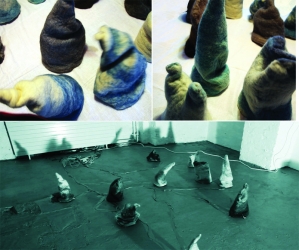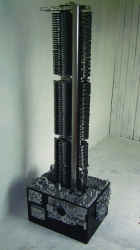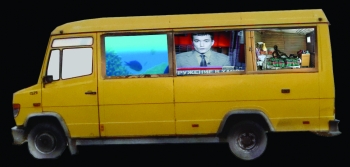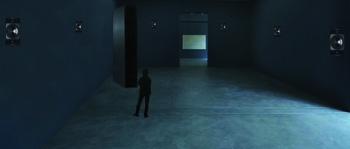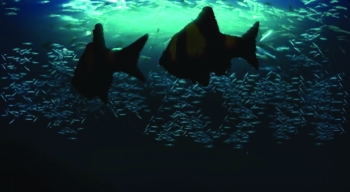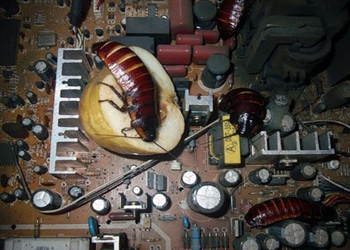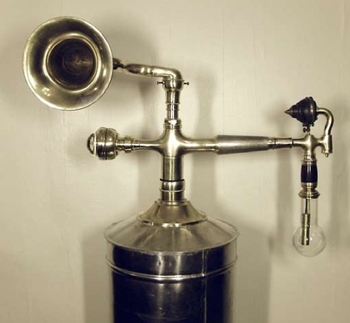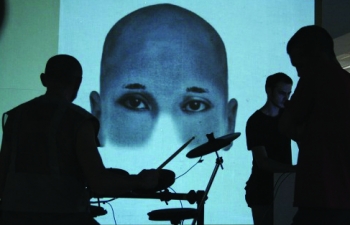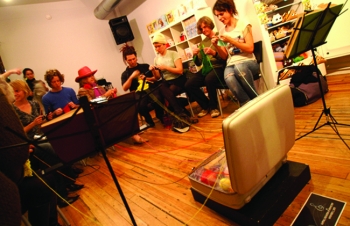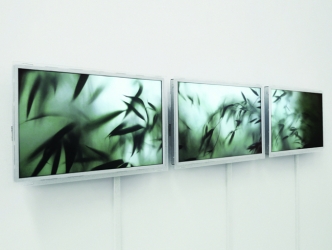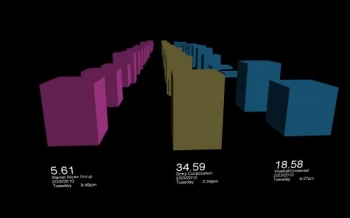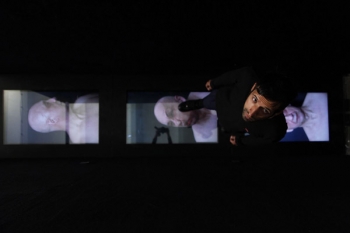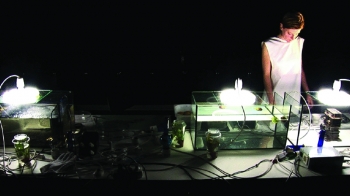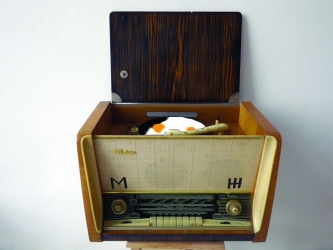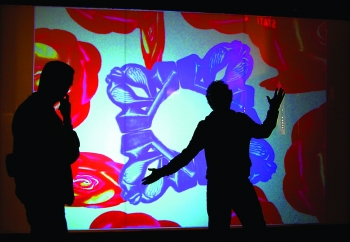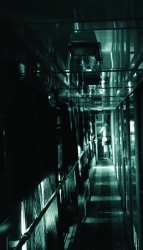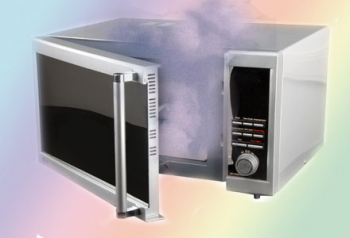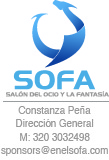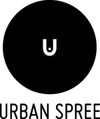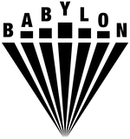Program: Exhibitions
Exhibitions
Anna Frants - Trembling Creatures.
Author: Anna Frants. Felting: Hannes Kivits. Robotics and Computer Programming: Aleksei Grachev. In Collaboration with CYLAND Media Lab, North Pole-New York.2010. Raskolnikov in Crime and Punishment by Dostoevsky pondered a question: “Am I a trembling creature or have I the right?” This installation gives a positive answer to both parts of this compound question: Yes, you are a trembling creature, and yes, you have the right... to tremble from any change in the world around you as do these hats set into moving or, rather, into trembling by any motion or gesture of the viewer. Perhaps, they literally follow the mandate of the Apostle Paul and “work out their salvation with fear and trembling”. Or they remind us that life is movement unlike, for instance, immovable stones above the Arctic Circle that, ironically, served as an inspiration for this work.
Ludmila Belova — Time Capsule “Tower”.
Author: Ludmila Belova. Computer Programming: Sergey Komarov, Aleksey Grachev. St. Petersburg, Russia. 2010.The audio object “Tower”, opened for information reading and placed into the zone of art, is a time capsule of sorts, the one that covers the last half a century. The tower refers both to skyscrapers, that stand for progress, and to the Tower of Babel, that is a symbol of hubris. God punished people for their hubris and disunited them – people started speaking different languages and stopped understanding each other. Progress and human intellect have now untied them again with the help of Internet by affording them an opportunity to translate online from any language. In the making of this object, the artist used details of household appliances that got out of use and a portion of the musical instrument. Audio files that it contains are the sounds that have to do with technological progress.
Aleksandr Pozin, Inna Pozina, Sergey Komarov — Seven.
Aleksandr Pozin: Sculpture. Inna Pozina: Interactive Concept. Sergey Komarov: Sound, Lighting, Programming. St. Petersburg, Russia. 2010. The object is a show window with bronze sculptures. Their number is seven. These could be seven days of the week or seven senses; or else, seven states of consciousness, the seventh race, seven deadly sins… what do I know? I like intuitively to improvise with sculpture and I like the number seven. The object is connected to a keyboard that affects the sculptures with light and sound.
Sergej Denisov–Mechanical Bugs or “Grownup Toys”.
Author: Sergey Denisov.Development and Computer Programming: Sergey Komarov, Aleksey Grachev. St. Petersburg, Russia. 2010. Toys grew up and became independent – they no longer want to be played with and avoid people. Copies of their little fellow creatures, fearful and ugly, they, much like Frankenstein’s monster, do not know what to do with themselves in this world that is new for them. Little monsters became big monsters.
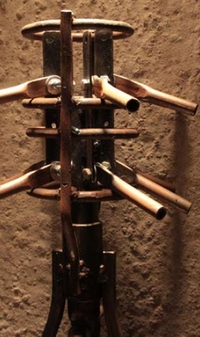
Marina Koldobskaya and Anton Chumak – Protozoa-2.
Concept: Marina Koldobskaya. Design, forging: Anton Chumak. Programming, mechanics: Oleg Rodionov. Production: Media Lab CYLAND. St. Petersburg, Russia. 2010. This is a porcupine, or a flower, or else a predatory shellfish – one from a series of small metal machines named Robots-Protozoa. They do not pretend to be either intelligent or useful. All that they are capable of doing is to scare or to be scared. They are aggressive, helpless and senseless. Needles-cords strike and miss the aim; in fact, they are totally unaware of the notion of “aim”. Thick armor covers an elementary mechanism: controller-microchip-motor. They look like the bronze-age armor or the makeshift gear of guerilla warfare. They cast doubt on our power over machines – and over ourselves.
Manja Alekseeva and Boris Kazakov – Jitney.
Authors: Marina Alekseeva and Boris Kazakov. St. Petersburg, Russia. 2010. An automobile of the “jitney” type, frequently encountered in St. Petersburg, is moving along the city route. However, what the viewer sees in the windows, instead of passengers, is the video sequence that is transmitted outside from inside. In this manner, things unimaginable are taking place within the minibus.
Aleksandra Dementieva — Monolith (Vespiary).
Author: Alexandra Dementieva.Computer Programming: Bart Vandeput. Hardware : Interface-Z. Construction : Peter Maschke. Co-production : SMART vzw, Adem vzw. Brussels, Belgium. 2010. The interactive installation Monolith deals with fear as a social phenomenon. By letting the viewer experience fear, it offers critical insights into the effect of cultural conditioning in the contemporary society. Furthermore, it provides a social commentary on the dominant conventions of a society, in which fear is constantly amplified by the media. Upon entering a dark room, seemingly empty except for a black box in the far corner, the viewer hears hostile sounds of buzzing wasps coming from speakers on the walls. As he moves towards the box, the buzzing, now coming from the box itself, gets stronger and stronger. When the viewer attempts to approach, the box jerks violently towards him, physically challenging him to step back.
Oleg Elagin – Lower Depths.
Author: Oleg Elagin. Samara, Russia. 2010. This video installation resembles a computer screensaver. Schools of ocean fish are unhurriedly moving to and fro in the space of sea deep lighted from above. However, they are gradually intertwining into a Russian expletive “na khuy” (“F*** it”). There are no punctuation marks after the expression. Nevertheless, one could place there both an exclamation point (and then the work turns into a radical statement addressed to other artists and viewers alike) and a question mark (in this case, the video becomes a query alluding to frailty and futility).
Evgenija Konovalova – Big Chow-down.
Author: Evgenia Konovalova. St. Petersburg, Russia. 2010. Characters in this video are the Madagascar cockroaches that live in the artist’s computer and, all day long, chew wires, fruit and each other. Two such specimens were bought at a market and placed into a juicer during the celebration of Daniil Kharms’s centennial. After that, they safely made it through the winter in the cold artist’s studio of a half-empty building and produced the abundant progeny that, among other things, participated in various art projects.
mikhael a crest sator ArXeNeKrOHeN— bragophone ASTRA PISCATORIUM.
Author: mikhael a crest sator ArXeNeKrOHeN. Russia.2010. The bioactive installation Astra Piscatorium or Fishermen’s Star is a projection of the system of the “corner stone” in the public space.
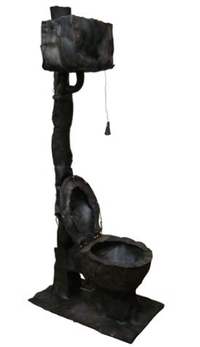
Vladimir Kozin – Overture
Author: Vladimir Kozin. Programming: Sergey Komarov, Aleksey Grachev. Supported by CYLAND medialab. St. Petersburg, Russia. 2010
My small artist’s studio (three rooms and a corridor) used to house a common St. Petersburg communal apartment. Its legacy included the toilet room with a monumental cast-iron sewage pipe and a hanging dump tank that, by my reckoning, was over 50 years old. This strange object (I call it “plateau of humanity”) evokes, all at the same time, a throne, a guillotine and an electric chair… At first, I rendered it in actual size out of black rubber for tires, and then I came up with an idea to give a voice to the object: to record authentic sounds of flushing or running water and to croon various songs that the view will hear upon approaching my object.
Vova Lilo – Drumpainting Identikit.
Artistic Concept, Work with Images: Vova Lilo.Computer Programming: Sergey Komarov, Aleksey Grachev Electronic Drums: Valeriy Morozov. St. Petersburg, Russia. 2010. During the demonstration of this interactive media installation, anybody who wishes can create his own identikit and print out the resulting image. For this, one needs to sit down at the drum set, drum one’s own rhythm and push the print button on the printer. With each drum stroke, some part of the face will be replaced on the screen. These parts (modules) have a predetermined number and can sometimes be repeated in combinations. A number of possible combinations is several thousands.

Dmitry Shubin – Carte Blanche
Author: Dmitry Shubin. St. Petersburg, Russia. 2010
This interactive installation is based on the transformation of an image, read off by a webcam, into a sound. The musical texture changes depending on the nature of a specific room, number of listeners as well as lighting and acquires, this way, features of a distinctive “technological aleatory composition”. The cam “scans” the space before it, reacting to detected motions: consequently,listeners themselves become direct performers of the concert.
Laure Drogoul -Symphonic Stitch.
Author: Laure Drogoul.Created with Support of Harvestworks Media Center. Baltimore, USA. 2007. This interactive installation invites viewers to participate in a musical knitting circle. The participants knit in unison creating a singular knit environment of light and sound. Their needles are equipped with tiny microphones that amplify the percussive nature of the knitting process. The sound is then mixed and played back live. The installation becomes a manifestation of the knitters’ collective process and a symphonic expression of the craft. The sound changes are based on the knitters’ stitches, needles, yarn and chosen patterns (for instance, the score might be the pattern for a cable knit sweater).
Ryan Wolfe — Study For a Perfect Storm.
Author: Ryan Wolfe. USA and Germany. 2009—2010. This series of installations creates a visually and viscerally believable natural environment that blurs parameters of a virtual experience with reality. In this interactive video installation, the viewer's presence is the catalyst triggering a storm to gain or lose momentum across a field of bamboo. The technologically generated storm subsides the longer the viewer remains watching. The viewer has an active role in soothing or perpetuating the wind blowing in this familiar yet fantastical world.
Andrew Demirjian -Week In Review.
Author: Andrew Demirjian. New Jersey, USA. 2010. The Week in Review is an interactive audiovisual installation that maps a week of stock prices fluctuations of the three largest music industry companies to sound and images. Participants are able to “play the market” creating compositions using a turntable, LED clock and responsive calendar. The Week in Review highlights the role of the global marketplace in music and reverses the traditional industry relationship that turns speculations on music into money; instead it turns speculations on money into music.
Georgi Begun - Trespassing.
Author: Georgi Begun. Berlin, Germany. 2010. The viewer-participant of this interactive video installation consumes it through the destruction of the artist. Each step upon the monitors throws the artist’s face into a vast number of distorted phases, screaming and wailing with each movement. Inside the Trespassing, you are literally walking the line of the artist’s inner psychology.
Jan-Peter E.R. Sonntag — sonArc::ion#1-Prologue.
Composition/Script/Installation/Directing: Jan-Peter E.R. Sonntag. Performers: Heike Buchfelder, Harry Kügler, Michael Vorfeld, J-P. E.R. Sonntag. Camera: Christfried Hübner. Programming and Video-postproduction: Thomas Plömtzke. Sound and Programming: Harry Kügler, J-P. E.R. Sonntag. Hardware: Jens Bakenhus, J-P. E.R. Sonntag. Costume Design: Thomas Zäpf. Stills: Stefano Vide. Production Management: Klaus C. Ulbricht. Berlin, Germany. 2005/2009. This video installation is based on the chamber opera staged in Berlin in 2005. Sonntag, whose artistic roots reach back to minimal and conceptual art as well as to experimental music, has repeatedly cooperated with scientific laboratories. With this project, the artist has been in search of the essence of electricity and the possibility of domesticating lightening: that is, in search of the electric/electronic sources and, at the same time, visions of our media age. Sonntag has grappled with the possibility of encoding open high-voltage plasma. In this video-installation, open high-voltage plasmas transform electrical energy into light – almost the entire spectrum of electromagnetic waves – create sound waves and can simultaneously send and receive.
Costantino Ciervo — Target.
Author: Costantino Ciervo. Berlin, Germany. 2010. This interactive video-object imitates a dartboard consisting of 5 steel circles in two alternating colours. The viewer hears a monotone female voice speaking the words «yes» or «no». When he stops straight in front of the object, he suddenly sees a portrait of himself, taken by an observation camera which is hidden inside the object. This way the artificial dartboard functions as a kind of decoy, creating a paradox situation for the viewer/player: if the player tries to hit the bull's eye, he will kill himself. The work is a subtle critique of the «black and white» ideology of capitalism, culture and ideology.
Elena Gubanova – Breakfast.
Author: Elena Gubanova. St. Petersburg, Russia. 2010. An LP with the picture of fried eggs is turning on top of the radio-recorder Latvia. The LP is constantly skipping. The viewer can turn the radio’s two knobs in different directions. On the left, a male voice is captured; on the right – a female one. The viewer can tune them at his own discretion. The voices can intersect in a dialogue, be separate or overlap. The object’s principal theme is the difficulty of mutual understanding, of a dialogue. A man and a woman only air their thoughts and feelings, but they don’t hear each other. A woman’s statements are more emotional; those of a man – more didactic. These are like different waves in a radio. Each participant transmits his/her wave on his/her own frequency. Through the participation of a third party (a viewer, a stranger, a witness), a temporary dialogue can be created.
PinkPink Sorbet— Cyland sl Odditorium. House Bugs.
Artists exhibited: Igor Ballyhoo, Glyph Graves, L!Aura Loire, Selavy Oh, Scottius Polke, Sledge Roffo, Pinkpink Sorbet, Misprint Thursday, Betty Tureaud and Magggnnus Woodget. Vienna, Austria. 2010. At this workshop, the Viennese artist Pinkpink Sorbet who is coordinating and constructing Cyland in the virtual world “Second Life” talks about this virtual space and shows the virtual group exhibition that she arranged for this year’s CYBERFEST. The exhibition takes place synchronously to the festival in real life, and deals with the same motto: “House bugs”
Gregoire Zabe and Valérie Bouvier — Buddhabrot Shop.
Concept: Grégoire Zabé. Graphics: Valérie Bouvier. Php&Vrml Programming: Frédéric Le Saout, Strasbourg, France.2005. This is a hybride (online&in situ) installation. [ONLINE] On the one side, a website on which users create digital sculptures generated from a simulated online purchase. On www.buddhabrotshop.com, web surfers choose from a selection of objects, and define the number, color and size of the objects they wish to get. While validating their order, they gradually create a 3d interactive digital sculpture, generated from their choice. These sculptures are then registered in a database which will contain all the generated objects. [IN SITU] On the other side, a projection screen is placed in a shop window, where the sculptures thus generated are projected in real time. There is absolutely no possible interaction in this spectator's point of view.

Sonicself — Mosaicwall
Curator: Jolanta Gora-Wita. Artists: Damian Catera, Sonanaut, Denny Daniel, Pandayaro. 2010
In this installation, the artists examine the ever-increasing confluence of audio and visual experiences in contemporary culture. The selected artworks will bridge disparate audio practices by pairing sound artists, musicians and video artists with a goal that their collaborative projects will expose and underscore their shared languages. This cross-fertilization of sound and video will be manifested in the site-specific digital installation on iPods.
Anna Frants — Episode On A Train.
Author: Anna Frants. New York, USA. 2010. Most of daily visual and aural paradoxes pass unnoticed by a human being; they are perceived as a given, as a part of the routine reality. This video installation, based on a play of chiaroscuro and optical illusions on a moving train, invites the viewer to recall the genre of trompe l’oeil, so popular in the Russian art of XVII and XVIII centuries and defined by Yuri Lotman as “…a game on the edge that calls for a sophisticated semiotic sense and testifies to complex dynamic processes that, as a rule, develop at the periphery of art before they capture its central spheres. It is, in fact, the imitation of authenticity that turns a notion of conditionality into a conscious issue whose boundaries and measure are detected by both an artist and his audience”.

Anna Frants and Marina Koldobskaya – We Are Here (audio installation).
Authors: Marina Koldobskaya and Anna Frants. St. Petersburg, Russia, and New York, USA. 2010. The viewer is going through a long semi-dark corridor and suddenly right nearby somebody’s breathing, heavy and powerful. It’s the breathing of an invisible giant. Somewhat farther along, there are sighs of a sleeping child, easy and peaceful. Still farther, some old and, apparently, sick person is wheezing. The exiting viewer is accompanied by a deep sigh of relief. These sounds act as a reminder: We are here, we are always here, we are right next to you. Who are they, the invisible ones? Genii loci? Prisoners of an old fortress? Bogeymen, wood goblins, poltergeists? Inhabitants of our memory? An elementary audio recording awakens ancient animism in the soul of a modern person – everybody is alive; everything is alive.
Anastasija Maksimova -Interactive Instrument “Lampophone”.
The Prometheus Center Concept: Anastasia Maksimova. Design: Olga Begovatova. Kazan, Russia. 2010. This is a curious percussion musical instrument, in which a light source – a bulb – is used as a sound source. The unusual shape of light bulbs produces an interesting sounding upon tapping. For amplitude of the musical range, some bulbs are colored in different fashion to achieve the tonal increase or decrease. Without exertion, but with a positive charge, everyone can try oneself as a lampophone player.
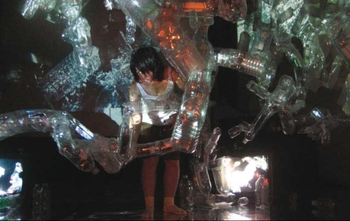
Katherine Liberovskaya and Keiko Uenishi – LandFilles/Dis (p) lay Waste.
Authors: Katherine Liberovskaya and o.blaat/Keiko Uenishi. Montreal, Canada, and New York, USA. 2009. The installation-performance (install-action) proposes a reflection on daily waste through creative processes. Hundreds of transparent plastic bottles of all shapes and sizes are collected from the local area and used for the construction of a sculpture/environment of suspended freeform bottle cluster 'structures' that will become instruments for the audiovisual 'performance' during which the artists interact with the structures through audio feedback (Larsen effect) deriving sounds from the hollows and shapes. This constantly changing relationship is captured, processed and projected via diverse cameras and video feedback effects.
Anastasija Maksimova – Sound Installation “Hope You Enjoyed Your Steam”.
The Prometheus Center Concept: Anastasia Maksimova. Technical Implementation: Sergey Alekseev. Kazan, Russia. 2010. Thanks to an engineering fix to this object, common to every kitchen, one could hear a world that is invisible, but indisputably existing in our vicinity. This nano-version of a Russian bathhouse will allow everybody virtually to participate in the Russian favorite pastime and, by doing so, to acquire tons of positive emotions.

Phill Niblock and Katherine Liberovskaya - From Field to Process.
Curators: Phill Niblock and Katherine Liberovskaya. Artists: Al Margolis, Phill Niblock and Jim Bell. USA and Canada. This project demonstrates three approaches to sound collage based on different ways of fusing field recordings with electronic and digital processing by three North American composers/sound artists.



